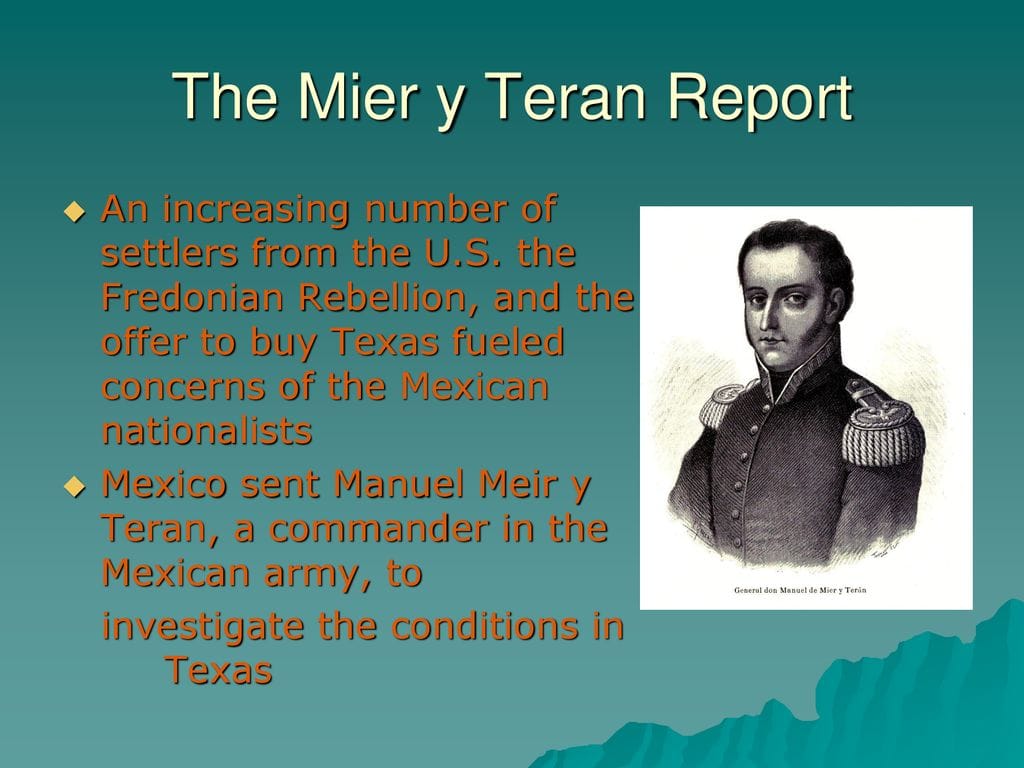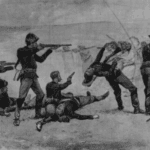Unmasking the Tensions: A Glimpse into 1828 Texas
The year is 1828. Texas, a vast and sparsely populated land, is a melting pot of cultures, a stage set for a clash between Anglo-American settlers and Mexican authorities. At the heart of this brewing conflict lies the Mier y Terán Report, a document that would serve as a chillingly accurate prediction of the Texas Revolution. Commissioned by the Mexican government following the Fredonian Rebellion (1826-1827), General Manuel de Mier y Terán’s investigation offered a stark warning, a glimpse into the simmering tensions that threatened Mexico’s hold on its northern territory.
A Demographic Time Bomb: The Influx of Anglo-Americans
Mier y Terán’s journey through Texas revealed a dramatic demographic shift. Anglo-American settlers, lured by the promise of cheap land under the Mexican Colonization Law of 1824, were flooding into Texas, rapidly outnumbering the Mexican population. In some areas, the ratio was as high as five to one. This influx, while beneficial for development, raised concerns within the Mexican government about maintaining control and cultural cohesion. This demographic imbalance, possibly exacerbated by continued American immigration, likely contributed to a sense of unease and a perceived threat to Mexican sovereignty.
Cultural Collision: A Clash of Customs and Laws
Beyond sheer numbers, the Mier y Terán Report exposed a deep cultural divide. Anglo-American settlers, largely accustomed to a different legal system and cultural norms, often disregarded Mexican laws and customs. The issue of slavery, outlawed in Mexico but practiced by many Anglo-American settlers, became a particularly contentious point of conflict. This disregard for Mexican law likely fueled anxieties within the Mexican government and further strained relations between the two groups.
Economic Entanglements: The Growing Shadow of the United States
Mier y Terán’s report also highlighted the burgeoning economic ties between Texas and the United States. This strong economic connection likely raised anxieties about growing American influence. The Mexican government probably worried that these connections could pave the way for future annexation by its northern neighbor, potentially adding to their existing concerns about Anglo-American political dominance within Texas itself.
The Mexican Government’s Response: A Double-Edged Sword
Mier y Terán’s report, delivered to Mexican Foreign Minister Lucas Alamán y Escalada, served as a wake-up call. It emphasized the urgent need for action to prevent the loss of Texas. The Mexican government responded by implementing some of Mier y Terán’s recommendations, most notably the Law of April 6, 1830. This law aimed to curb American immigration, strengthen trade ties with Mexico, and bolster the military presence in Texas. Ironically, these measures, intended to stabilize the situation, further alienated the Anglo-American settlers, fueling resentment and pushing Texas further down the path to revolution.
The Law of April 6, 1830: Catalyst for Conflict?
While intended to assert Mexican control, the Law of April 6, 1830, may have inadvertently accelerated the march toward revolution. Its restrictions on American immigration and other provisions were perceived by Anglo settlers as oppressive and a direct threat to their autonomy. Some historians suggest that this law, though a direct response to Mier y Terán’s report, ultimately backfired, exacerbating the very tensions it aimed to quell.
The Road to Revolution: A Legacy of Unheeded Warnings
The Mier y Terán Report stands as a critical turning point in Texas history. It offered a prescient glimpse into the forces at play that would ultimately lead to the Texas Revolution. While some experts believe its warnings were tragically ignored, others suggest the Mexican government’s response, influenced by internal political dynamics and economic considerations, was simply inadequate to avert the looming conflict. Ongoing research continues to explore the complex interplay of factors that led to the Texas Revolution, and the Mier y Terán Report remains a vital piece of this historical puzzle. It underscores the importance of understanding cultural differences, demographic shifts, and political tensions in shaping the course of history and continues to inform discussions about immigration, cultural identity, and border security today. It also offers a valuable reminder that history is rarely simple, and considering different perspectives is crucial for understanding the past and its impact on the present. At the helm of the fleet and instrumental in shaping the outcome of World War II’s Pacific theater, Raymond Spruance, a distinguished admiral, left an indelible mark on naval history. This seemingly unrelated historical figure underscores the complexities of leadership and decision-making within a broader global context.
- Crypto Quotes’ Red Flags: Avoid Costly Mistakes - June 30, 2025
- Unlock Inspirational Crypto Quotes: Future Predictions - June 30, 2025
- Famous Bitcoin Quotes: A Deep Dive into Crypto’s History - June 30, 2025

















1 thought on “The Mier y Terán Report: A Harbinger of the Texas Revolution”
Comments are closed.